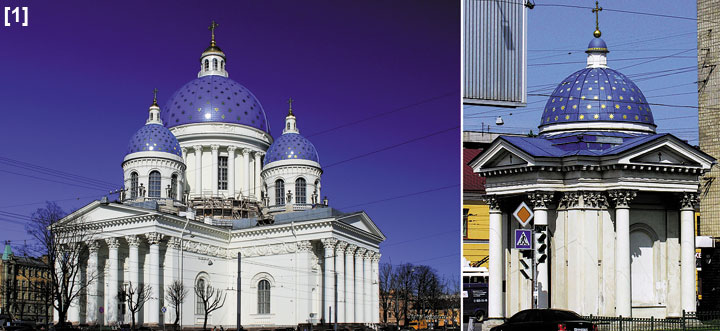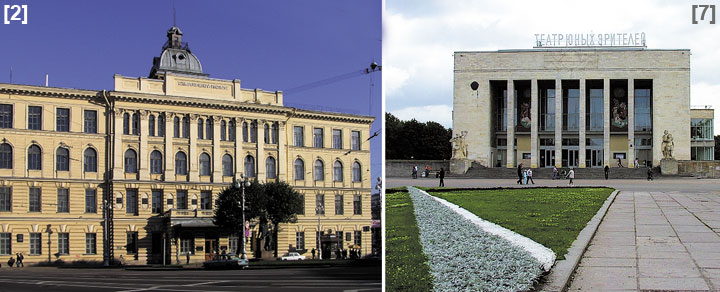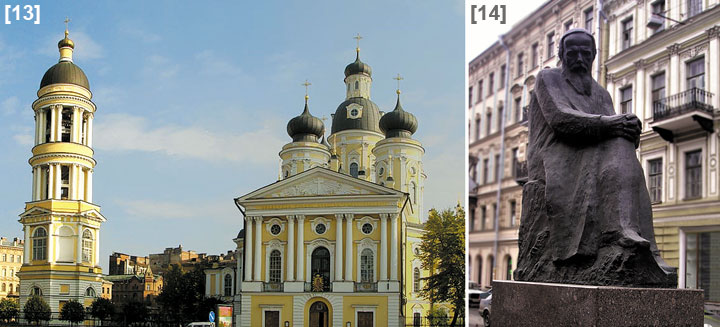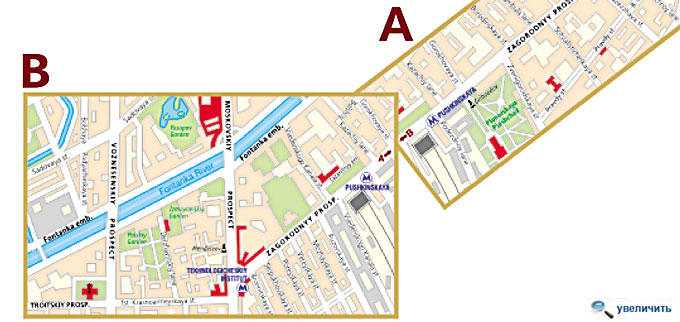ROUTE No. 9
SOUTH OF FONTANKA RIVER: TRINITY CATHEDRAL – ST. PETERSBURG INSTITUTE OF TECHNOLOGY – MONUMENT TO GEORGIY PLEKHANOV – ZAGORODNYY PROSPECT – VITEBSKIY RAILWAY STATION – FORMER SEMENOVSKIY PLATZ – THEATER OF YOUNG SPECTATORS –– MONUMENT TO ALEXANDER GRIBOEDOV – RIMSKY-KORSAKOV MEMORIAL APARTMENT – FIVE CORNERS – VLADIMIRSKAYA SQUARE – CATHEDRAL OF THE VLADIMIR ICON OF THE HOLY MOTHER – MONUMENT TO FYODOR DOSTOEVSKY – FYODOR DOSTOEVSKY LITERARY MEMORIAL MUSEUM
Now we cross the Fontanka River and move towards the bright blue painted domes of the Trinity Cathedral [1] – another prominent feature in the city center. Built between 1828 and 1835 by Vasiliy Stasov in the form of a Greek cross, the cathedral skillfully combines the Old Russian tradition in church architecture with neo-Classical elements. The four small domes together with the large dome and the portico create a pleasing pyramid effect. A frieze runs round the otherwise simple white facade. The cathedral rises to a height of more than 80 meters and dominates the skyline of the surrounding area.

The Trinity Cathedral was the regimental church of the Izmaylovskiy Regiment, one of the oldest guards regiments in the Russian Army. Memorial plaques to regimental officers killed in battles were mounted on the cathedral’s wall. After the cathedral’s opening, flags, keys from forts and other trophies that the regiment won in war campaigns were also housed in the cathedral.
The Trinity Cathedral was renowned for its collection of icons. Unfortunately, in 1922 most of the cathedral’s valuables were looted, and the thievery continued for several more years until the cathedral was finally closed in 1938. Only in 1990 did the cathedral return to the hands of the Russian Orthodox Church.
In August 2006, while under reconstruction, a fire started from a restoration scaffolding collapsed the main dome, destroyed one of the four smaller domes and severely damaged the interior. City authorities have pledged to restore the cathedral within the shortest time possible.
Walking further on down the 1-st Krasnoarmeyskaya Street you’ll soon reach the intersection of Moskovskiy and Zagorodnyy Prospects. At the corner one can view the monumental building of St. Petersburg Institute of Technology [2], founded in 1828 to train engineers for industry. The Institute’s alumni include Dmitriy Mendeleev, Pyotr Lebedev, Abram Ioffe and many other outstanding scientists. In 1925 a Monument to Georgiy Plekhanov [3] – the father of Russian Marxism – was unveiled in front of the Institute’s main building.
Zagorodnyy Prospect [4] runs from Moskovskiy Prospect to Vladimirskaya Square for 2 kilometers 700 meters. The prospect was laid in the 1740s according to a project planned by the Commission for the Building of St. Petersburg, which allowed city dwellers to develop country houses along the bank of the Fontanka River (hence the name Zagorodnyy, which means “beyond the city”). Starting from the second half of the 18th century, the prospect was built up with stone buildings.
In 1837 the Tsarskoselskiy Railway Station, presently called Vitebskiy Railway Station [5] was opened at No. 52. It was the first train terminal in Russia, connecting St. Petersburg with Tsarskoe Selo (Pushkin) and Pavlovsk. The present building of the railway station dates from 1904 and represents a remarkable example of Russian Art Nouveau with a dome, large Romanesque windows and decorative bas-reliefs on the pediment. One of the station’s halls is decorated with wall paintings, which show the history of Tsarskoselskiy Railway Station.
Further down the prospect, across Gorokhovaya Street, the former Semenovskiy Platz [6] opens off Zagorodnyy Prospect to the right. As in other peripheral areas of old St. Petersburg, there were barracks here in the 19th century. The Semenovskiy Guards Regiment was quartered along the southern side of Zagorodnyy Prospect and to the west of Zvenigorodskaya Street. The parade ground of the Semenovskiy Regiment, or the Semenovskiy Platz, was the scene of several grim episodes. Here in 1849 the cruel mock-execution of the members of the Petrashevsky Circle took place; 21 people, including writer Fyodor Dostoevsky, were sentenced to be shot, and only in the last moment were they told that their actual punishment would be a prison term. In the latter part of the 19th century the parade ground was made into a race track or hippodrome. After the revolution the place was renamed into Pionerskaya Square. A large part of this site is now occupied by the Theater of Young Spectators [7]. The company was founded in 1922 by Alexander Bryantsev and was one of the first Russian youth theaters. The present theater was opened in 1962, continuing its tradition of producing plays for children and young adults. Close to the square entrance stands a larger-than-life Statue of Alexander Griboedov [8] – a Russian diplomat, playwright and composer. He is recognized as a writer of the brilliant verse comedy “Woe from Wit”, still one of the most often staged plays in Russia.

A number of figures from world of music used to live on Zagorodnyy Prospect. Nikolay Rimsky-Korsakov Memorial Apartment [9] was opened in 1971 at No. 28. The museum is located in the apartment where the composer moved in 1893 and where he spent the last 15 years of his life. It was here that Rimsky-Korsakov composed 11 operas, including “Sadko”, “Golden Cockerel” and “Fairy Tale of Tsar Saltan”. The apartment served as a music center of St. Petersburg. Mikhail Vrubel, Sergey Rachmaninov, Valentin Serov, Vasiliy Stasov, Igor Stravinsky and Fyodor Chalyapin attended Rimsky-Korsakov’s Music Wednesdays.
Almost opposite the street you will find the Jazz Philharmonic Hall [10]. Founded by legendary jazz violinist and composer David Goloshchyokin, this venue represents the traditional side of jazz.
Further along the prospect you’ll pass the Five Corners [11] – a traditional informal name of the crossroads, formed by Zagorodnyy Prospect, Lomonosova Street, Rubinshteyna Street and Razezzhaya Street. An apartment house crowned with a turret at the top and facing the crossroads with its sharp angle was constructed in 1913 in Neoclassical style and formed the focus of the Five Corners ensemble.
Finally you reach the Vladimirskaya Square [12], named so after the Cathedral of the Vladimir Icon of the Holy Mother. In the 18th century the square and streets around it were assigned for the settlement of court craftsmen and workers. The image of the present square was formed in the late 19th century.
Cathedral of the Vladimir Icon of the Holy Mother [13] dominates the Vladimirskaya Square. It was built to accommodate the Vladimir Icon of the Holy Mother. The founding of the church dates to 1746 when the first iconostasis was assembled. On August 25, 1748 a new wooden church was christened in the name of Vladimir Icon of the Holy Mother. Because the construction of the current stone church dragged on for more than 20 years and several different architects were involved in its design and construction, the Cathedral of the Vladimir Icon of the Holy Mother is not credited to any one architect. However, Giacomo Quarenghi designed the impressive bell tower adjacent to the church.

In the last years of his life Fyodor Dostoevsky was a parishioner of the Cathedral of the Vladimir Icon of the Holy Mother. Across the street from the church stands the Monument to Fyodor Dostoevsky [14], unveiled in 1997. St. Petersburg is often referred to as the city of Fyodor Dostoevsky. The great novelist spent most of his adult here and wrote some of his world famous novels, including “The Idiot”, “The Brothers Karamazov” and “The Crime and Punishment”. Moreover, in Dostoevsky’s works the atmosphere of St. Petersburg is so vividly depicted that it becomes more of a character than a setting.
Only one block away, on Kuznechnyy Lane, is Fyodor Dostoevsky Literary Memorial Museum [15], opened in 1971. The novelist moved there with his family in October 1878 and was to reside until the day of his death, January 28, 1881. It was in this house that his last novel, “The Brothers Karamazov”, was written.
